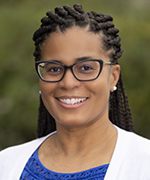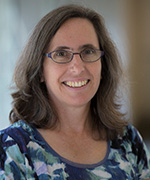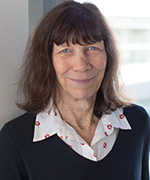Thyroid cancer
The thyroid is a gland that produces important hormones for the body. Located at the base of the throat, it has a right and a left lobe; one lobe falls on either side of the windpipe (trachea). Thyroid hormones control heart rate, body temperature, the amount of blood calcium and metabolism, or how quickly food is changed into energy. People with an overactive thyroid (hyperthyroidism) experience an increase in these effects, and people with underactive thyroid (hypothyroidism) experience decreased effects.
There are four main cancer types that can form in the thyroid gland: papillary, the most common type; and follicular, medullar and anaplastic.
The UC Davis Comprehensive Cancer Center is a regional treatment center for adults and children with endocrine tumors. Thyroid cancer cases are discussed among a panel of experts from different disciplines to ensure that patients are provided with the best possible treatment options. It also offers patients access to a large number of pediatric and adult clinical trials of investigational treatments.

Thyroid nodules can be evaluated for cancer and diagnosed using a number of different tests. Because the type of thyroid cancer can be hard to diagnose, patients should ask to have biopsy samples checked by a pathologist who has experience diagnosing thyroid cancer. These tests can include:
Physical exam and history: An exam of the body to check general signs of health, including for signs of disease, such as lumps, swelling in the neck, voice box, or lymph nodes. A history of the patient’s health habits and past illnesses and treatments also will be taken.
Laryngoscopy: A procedure in which the doctor examines the larynx (voice box) with a mirror or with a laryngoscope (a thin, lighted tube).
Blood hormone or chemistry studies: A blood sample is checked to measure the amounts of certain hormones or substances released into the blood by organs and tissues in the body. A higher or lower than normal amount of a substance—such as of thyroid-stimulating hormone (TSH), or of calcium—can be a sign of disease in the thyroid.
Ultrasound exam: A non-invasive study in which high-energy sound waves are bounced off internal tissues or organs, such as the thyroid, and make echoes. The echoes form a picture of body tissues called a sonogram, which can then show the size and location of a thyroid nodule and whether it is solid or a fluid-filled cyst. An ultrasound cannot differentiate between cancer and benign tumors, so further evaluations must be conducted. If suspicious or large lymph nodes are found, they can be tested with a fine-needle aspiration (FNA) biopsy.
Fine-needle aspiration biopsy of the thyroid: The removal of thyroid tissue using a thin needle. The needle is inserted through the skin into the thyroid. Several tissue samples are removed from different parts of the thyroid. A pathologist then views the tissue samples under a microscope to look for cancer cells.
Sources: National Cancer Institute, American Association of Endocrine Surgeons and UC Davis Comprehensive Cancer Center
Thyroid cancer may not cause noticeable symptoms right away. Thyroid nodules are sometimes found during a routine physical exam. However, an enlarged tumor may become more visibly pronounced, or symptoms increase, as the cancer progresses. Some symptoms may include:
- A swelling or lump in the neck
- Trouble breathing
- Trouble swallowing
- Hoarseness
- Sense of pressure or fullness in the neck below the Adam’s apple
Sources: National Cancer Institute, American Association of Endocrine Surgeons and UC Davis Comprehensive Cancer Center
Risk factors for thyroid cancer include the following:
- Being female
- Being exposed to radiation to the head and neck as a child, or being exposed to radiation from an atomic bomb. The cancer may occur as soon as five years after exposure
- Having a history of goiter (enlarged thyroid)
- Having a family history of thyroid disease or thyroid cancer, or certain genetic conditions. Medullary thyroid cancer in particular can be due to the change in a certain inherited gene; there are currently tests that can potentially find the changed gene before the cancer appears
- Being Asian
Sources: National Cancer Institute, American Association of Endocrine Surgeons and UC Davis Comprehensive Cancer Center
Surgery is often performed as an outpatient or overnight procedure. Tumors of the thyroid are typically managed with minimally invasive surgery. All surgeries utilize real-time recurrent laryngeal nerve monitoring to help prevent injury to the recurrent laryngeal nerve, the nerve to your voicebox.
Specific surgical techniques for thyroid cancer can include:
- Thyroid lobectomy: Removal of one-half of the thyroid gland.
- Total thyroidectomy: Removal of the entire thyroid gland.
- Minimally invasive thyroidectomy: Removal of part or all of the thyroid gland using a small (1.5- to 2-inch) incision. Patients undergoing a small-incision procedure may experience less pain and an improved cosmetic outcome than with the traditional open incision.
- Central neck lymph node dissection: Surgery to remove lymph nodes on either side of your trachea/windpipe. These lymph nodes are the most likely to harbor a cancer from an underlying thyroid malignancy.
- Modified radical neck dissection: Removal of the fat pad that contains the lymph nodes in the neck along the jugular vein and central neck. This procedure is considered “modified” because the surgeon attempts to preserve important muscles, nerves and blood vessels in the neck.
- Ultrasound-guided blue-dye localization of recurrent thyroid cancer: For patients with recurrent thyroid cancer, removing all sites of disease can be complicated. Injection of a blue dye with ultrasound can help our surgeons perform a targeted surgery to remove recurrent cancer while minimizing the risk.
More about surgical interventions for thyroid cancer
Sources: National Cancer Institute, American Association of Endocrine Surgeons and UC Davis Comprehensive Cancer Center
Endocrine Surgery/Thyroid Surgery
 Michael Campbell, M.D.
Michael Campbell, M.D.
Associate Professor of Surgery
 Claire Graves, M.D.
Claire Graves, M.D.
Assistant Professor of Surgery
Otolaryngology-Head and Neck Surgery
 Marianne Abouyared, M.D.
Marianne Abouyared, M.D.
Assistant Professor of Otolaryngology
Head and Neck Oncology and Microvascular Surgery
 Arnaud F. Bewley, M.D.
Arnaud F. Bewley, M.D.
Assistant Professor
 Andrew Birkeland, M.D.
Andrew Birkeland, M.D.
Assistant Professor of Otolaryngology
Head and Neck Oncology and Microvascular Surgery
 Scott Fuller, M.D., M.Sc.
Scott Fuller, M.D., M.Sc.
Associate Physician, Department of Otolaryngology
Neurological Surgery
 Orwa Aboud, M.D., Ph.D.
Orwa Aboud, M.D., Ph.D.
Assistant Professor of Neurological Surgery
 Orin Bloch, M.D., FAANS
Orin Bloch, M.D., FAANS
Associate Professor of Neurological Surgery
 Kiarash Shahlaie, M.D., Ph.D., FAANS
Kiarash Shahlaie, M.D., Ph.D., FAANS
Associate Professor of Neurological Surgery
Hematology and Oncology
 Jonathan Riess, M.D., M.S.
Jonathan Riess, M.D., M.S.
Associate Professor of Internal Medicine, Hematology and Oncology
Dietitians
 Danielle Baham, M.S., R.D.
Danielle Baham, M.S., R.D.
 Kathleen Newman, R.D., C.S.O.
Kathleen Newman, R.D., C.S.O.
Genetic Counselors
Social Workers
 Sara Chavez, L.C.S.W., O.S.W.-C., A.C.H.P.-S.W.
Sara Chavez, L.C.S.W., O.S.W.-C., A.C.H.P.-S.W.
 Sarah Conning, L.C.S.W., O.S.W.-C.
Sarah Conning, L.C.S.W., O.S.W.-C.





 Nicole Mans, M.S., L.C.G.C.
Nicole Mans, M.S., L.C.G.C. Jeanna Welborn, M.D.
Jeanna Welborn, M.D.